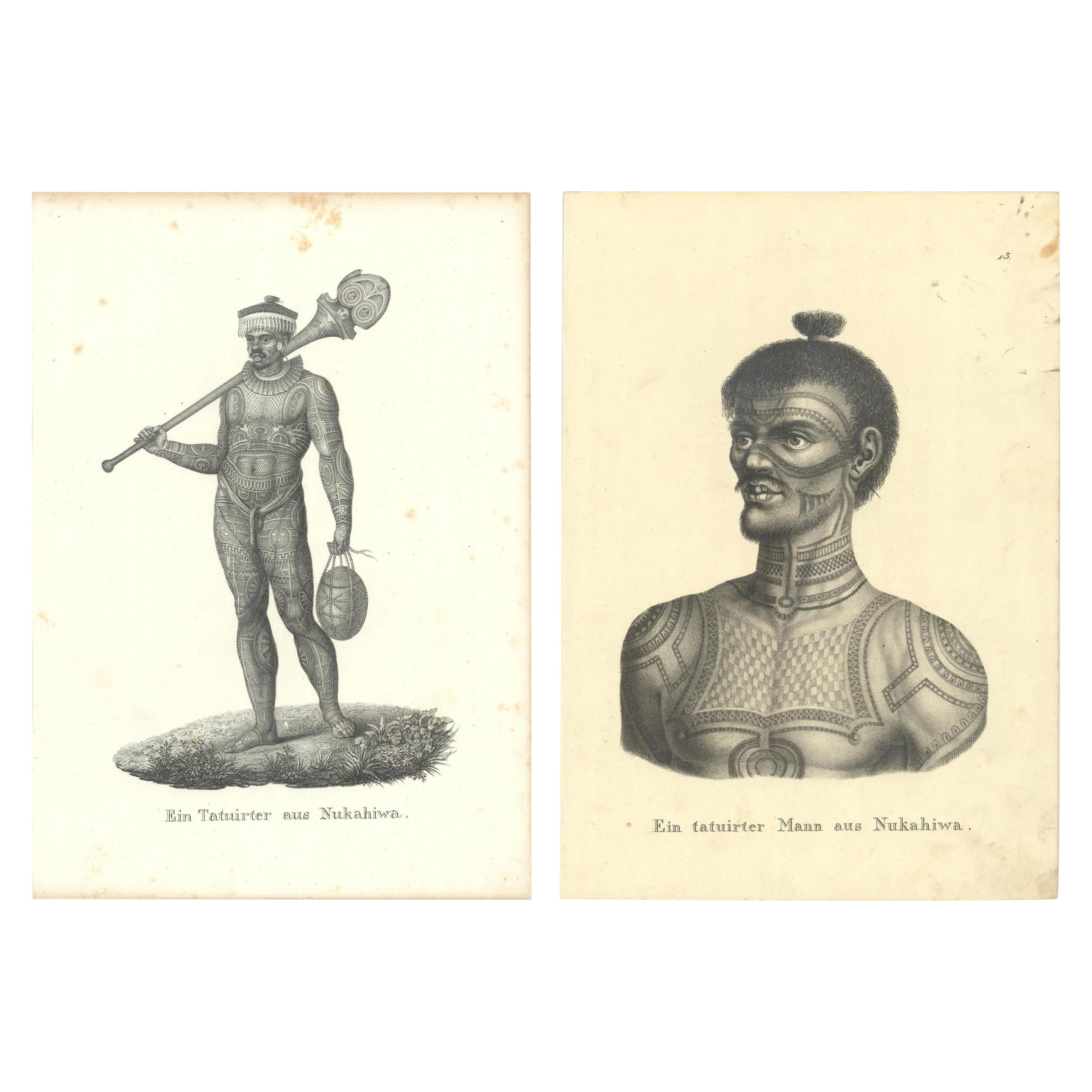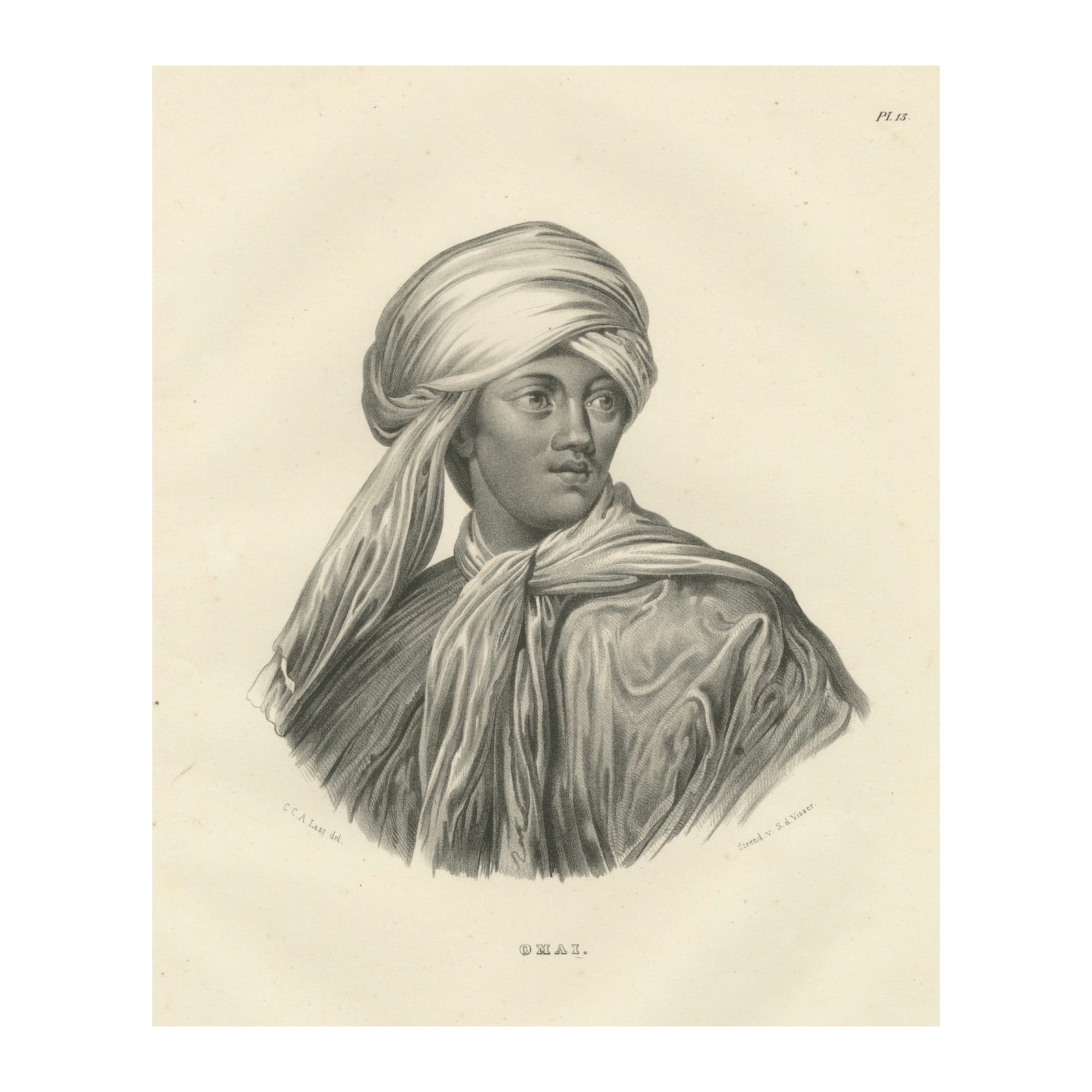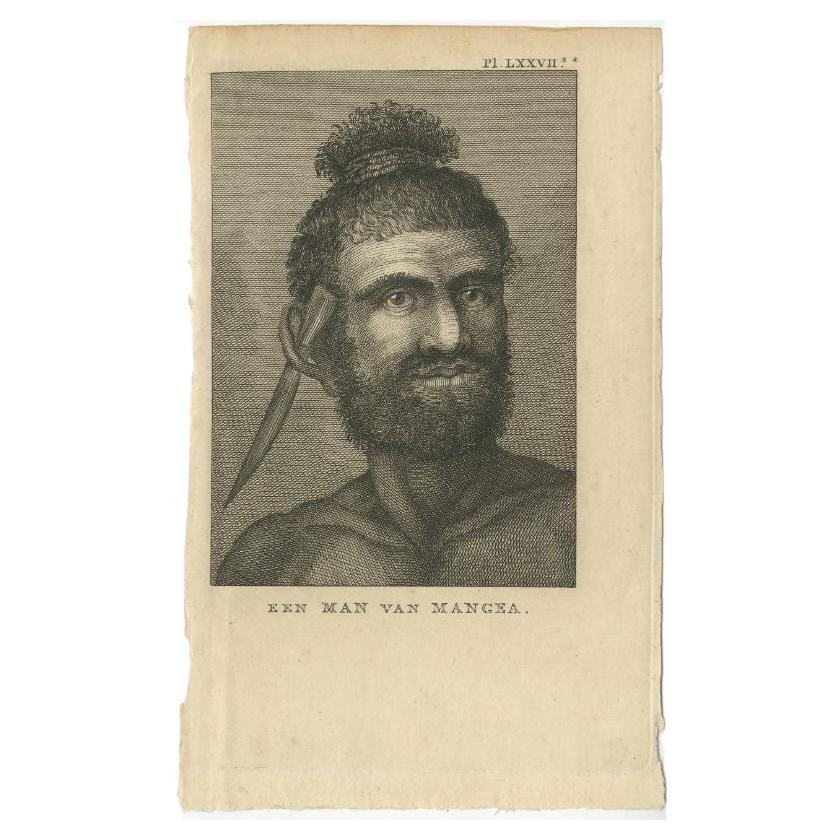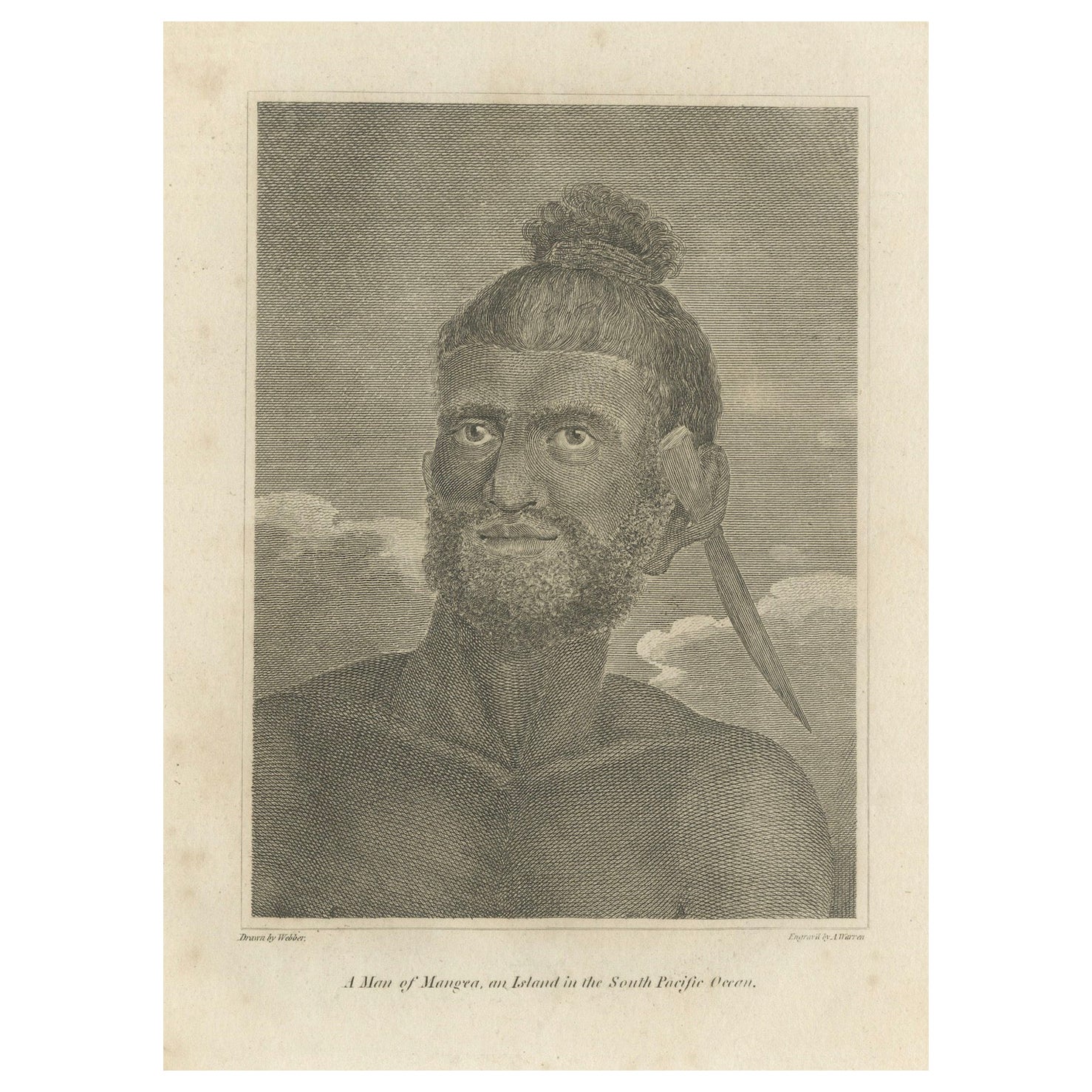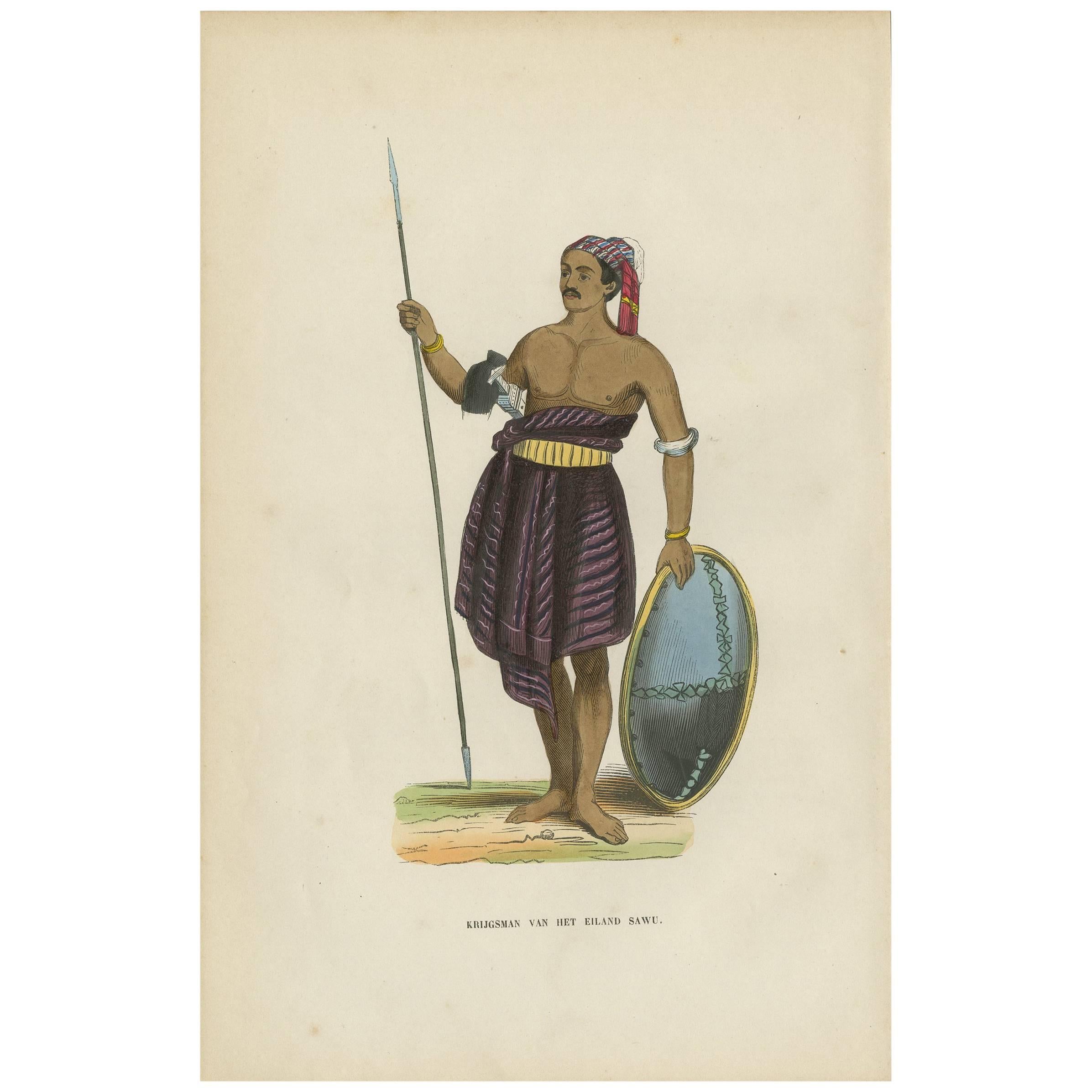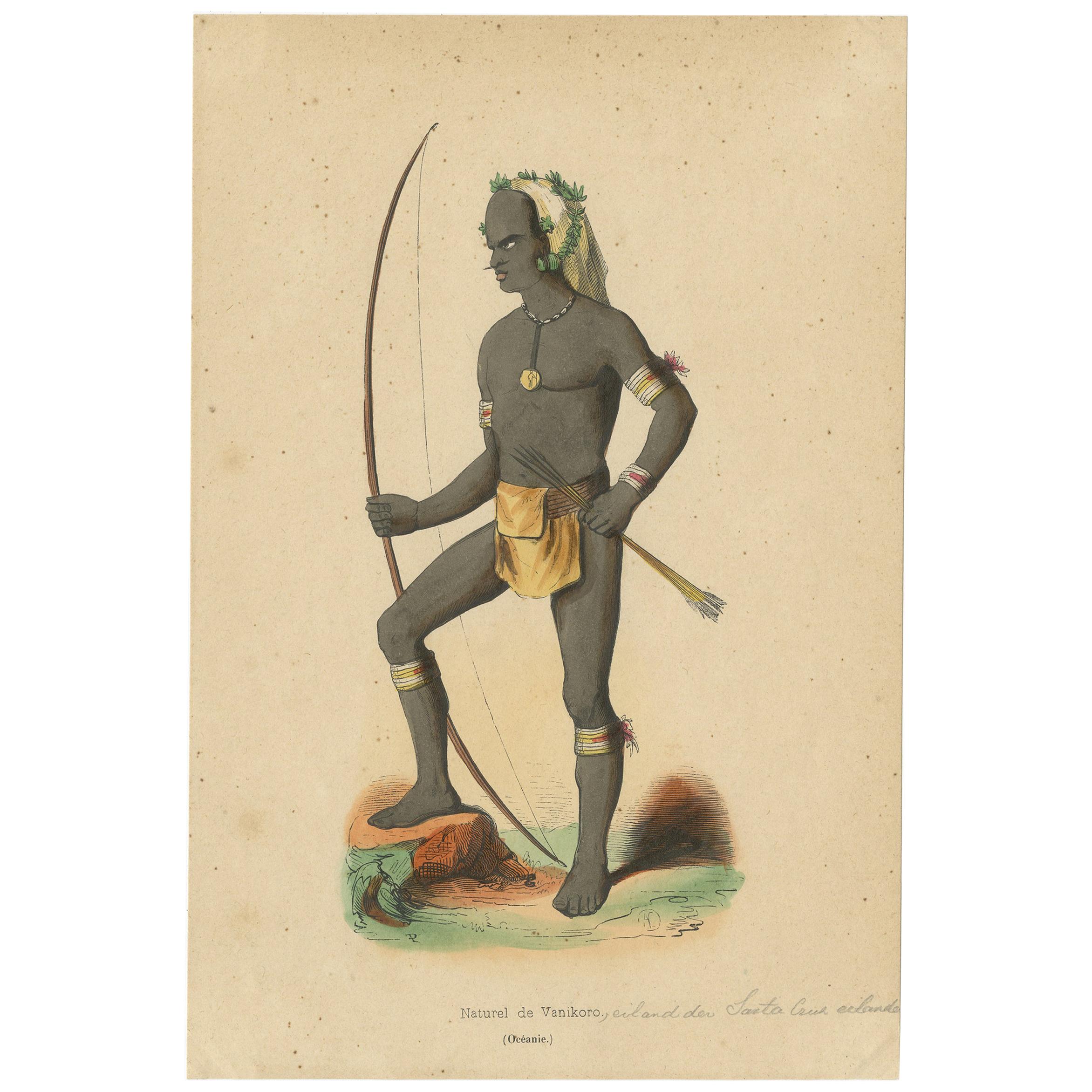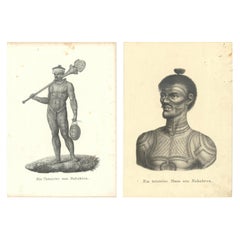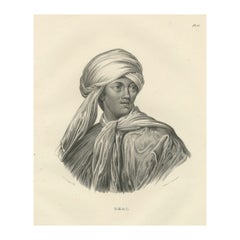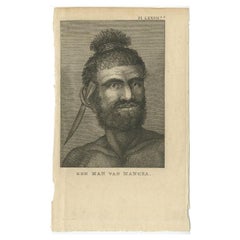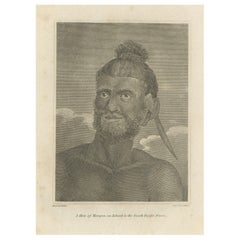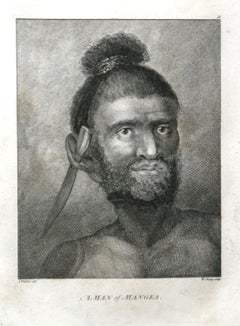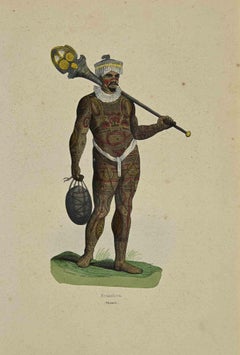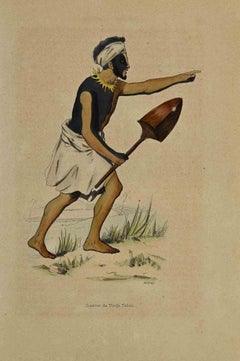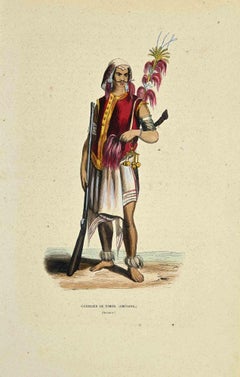Items Similar to A Tattooed Man from Nuku Hiva, French Polynesia, by Karl Joseph Brodtmann, 1836
Want more images or videos?
Request additional images or videos from the seller
1 of 12
A Tattooed Man from Nuku Hiva, French Polynesia, by Karl Joseph Brodtmann, 1836
$395.39
$527.1825% Off
£294.34
£392.4525% Off
€330
€44025% Off
CA$541.58
CA$722.1125% Off
A$602.36
A$803.1425% Off
CHF 314.53
CHF 419.3825% Off
MX$7,330.05
MX$9,773.4025% Off
NOK 4,017.06
NOK 5,356.0825% Off
SEK 3,767.29
SEK 5,023.0525% Off
DKK 2,512.17
DKK 3,349.5725% Off
Shipping
Retrieving quote...The 1stDibs Promise:
Authenticity Guarantee,
Money-Back Guarantee,
24-Hour Cancellation
About the Item
This lithograph by Karl Joseph Brodtmann presents a tattooed man from Nuku Hiva, an island in the Marquesas Islands, located in French Polynesia. The artwork captures the intricate and culturally significant tattoos that adorned the bodies of Marquesan men, reflecting their social status, identity, and the rich tattooing traditions of the region.
Description:
The lithograph depicts a man from Nuku Hiva with highly detailed and elaborate tattoos covering his face, neck, chest, and shoulders. Tattooing was a deeply ingrained cultural practice in the Marquesas Islands, where intricate body art represented various aspects of the individual's identity, including their status, achievements, and lineage.
- Tattoos: The tattoos on this man are extensive, covering his entire upper body with geometric patterns, circular motifs, and bands that encircle his arms and chest. The facial tattoos are particularly elaborate, forming symmetrical designs across his forehead, cheeks, and chin, which are consistent with the Marquesan tradition of tā moko, the art of body and face tattooing. These tattoos often signified bravery, social rank, and personal accomplishments. The chest is adorned with a checkered pattern, surrounded by detailed bands of tattooed designs, and the entire composition showcases the complexity and artistry of Marquesan tattoos.
- Hairstyle: The man’s hair is tied into a topknot, a traditional style often associated with Polynesian men of high status. His expression is neutral but dignified, emphasizing the cultural importance of his appearance.
This portrait not only emphasizes the individuality of the man but also highlights the broader cultural practice of tattooing in the Marquesas Islands, offering European audiences a detailed view of this intricate art form.
Maker:
Karl Joseph Brodtmann (1787–1862) was a Swiss lithographer whose works focused on ethnographic, scientific, and natural history subjects. His detailed illustrations of people from around the world contributed to European knowledge of distant cultures during the 19th century. Brodtmann’s ability to capture cultural details such as tattoos, clothing, and adornments in a realistic yet artistically compelling way made his work valuable to both scientists and art collectors.
Technique and Style:
This lithograph, like Brodtmann’s other works, was created using lithography, a method that allowed him to capture fine details and subtle shading. His style here combines ethnographic accuracy with a focus on the intricate beauty of the tattoos, which are carefully rendered to emphasize their patterns and symmetry.
The use of shading brings out the three-dimensionality of the tattoos, making them appear as if they are truly part of the man’s skin, while also highlighting the texture of his body. The portrait’s clean, simple composition ensures that all attention is drawn to the tattoos and their significance.
Cultural Context:
Tattooing in the Marquesas Islands was a central cultural practice for men, and receiving these intricate tattoos was a rite of passage that marked a man’s transition to adulthood. Tattoos in this region were not only decorative but also served as symbols of the individual’s rank, bravery, and personal history. Marquesan tattooing was considered one of the most elaborate and sophisticated tattooing traditions in Polynesia, with designs that often covered the entire body over the course of several years.
The man from Nuku Hiva depicted here must have been a person of high status within his community, as the extent and intricacy of his tattoos suggest that he had undergone many sessions of tattooing, a process that was both physically and spiritually significant.
Brodtmann’s depiction of this tattooed man provides European audiences with a glimpse into the tattooing practices of the Marquesas Islands, reflecting a broader fascination with the so-called "exotic" customs of Polynesian cultures during the 19th century. The portrait contributes to the ethnographic documentation of the time, offering insight into the complex artistry and cultural importance of tattooing in the Pacific Islands.
- Dimensions:Height: 12.8 in (32.5 cm)Width: 10.24 in (26 cm)Depth: 0 in (0.02 mm)
- Materials and Techniques:
- Period:
- Date of Manufacture:1836
- Condition:Condition: good, given age. General age-related toning and/or occasional minor defects from handling. Some stains along the right border, not affecting the image. Please study scan carefully.
- Seller Location:Langweer, NL
- Reference Number:Seller: BG-13176-151stDibs: LU3054341515852
About the Seller
5.0
Recognized Seller
These prestigious sellers are industry leaders and represent the highest echelon for item quality and design.
Platinum Seller
Premium sellers with a 4.7+ rating and 24-hour response times
Established in 2009
1stDibs seller since 2017
2,510 sales on 1stDibs
Typical response time: <1 hour
- ShippingRetrieving quote...Shipping from: Langweer, Netherlands
- Return Policy
Authenticity Guarantee
In the unlikely event there’s an issue with an item’s authenticity, contact us within 1 year for a full refund. DetailsMoney-Back Guarantee
If your item is not as described, is damaged in transit, or does not arrive, contact us within 7 days for a full refund. Details24-Hour Cancellation
You have a 24-hour grace period in which to reconsider your purchase, with no questions asked.Vetted Professional Sellers
Our world-class sellers must adhere to strict standards for service and quality, maintaining the integrity of our listings.Price-Match Guarantee
If you find that a seller listed the same item for a lower price elsewhere, we’ll match it.Trusted Global Delivery
Our best-in-class carrier network provides specialized shipping options worldwide, including custom delivery.More From This Seller
View AllCirca 1830 Schinz Prints: Tattooed Men of Nuku Hiva, Marquesas Islands
Located in Langweer, NL
Circa 1830 Schinz Prints: Tattooed Men of Nuku Hiva, Marquesas Islands
This set of two black-and-white lithographs from circa 1830 by Heinrich Rudolf Schinz depicts tattooed men fro...
Category
Antique 1830s Prints
Materials
Paper
$527 Sale Price / set
20% Off
Portrait of Omai, a Polynesian Man, by Karl Joseph Brodtmann, 1835
Located in Langweer, NL
This lithograph, titled Omai, by Karl Joseph Brodtmann, is an example of the artist’s ethnographic studies, showcasing a portrait of Omai, a notable figure from Polynesia who visited Europe in the 18th century. This work highlights Brodtmann’s interest in portraying individuals from distant lands, focusing on their unique cultural attire and expressions.
Description:
The portrait represents Omai, a Polynesian man who gained historical significance during the 18th century as one of the first Polynesians to travel to Europe. Omai (also known as Mai) was a central figure in the encounters between Polynesian and European cultures, having been brought to England by Captain James Cook in the 1770s.
- Clothing: Omai is depicted in an elegant wrap of flowing fabric, draped around his shoulders and tied in a loose, elegant fashion. His head is adorned with a large turban, a stylistic interpretation that may have been influenced by European artistic conventions when portraying foreign dignitaries or exotic figures. The fabric's folds and shading add a sense of depth and texture, showcasing Brodtmann’s mastery of lithography.
- Expression: Omai’s expression is poised and dignified, with his gaze directed slightly off to the side. The sense of serenity and composure in his face is typical of the European portrayals of him as an "exotic noble savage," a term that reflects the European fascination with non-Western peoples during the age of exploration.
The lithograph highlights both the individuality of Omai and the cultural significance of his travels to Europe, where he became a symbol of cross-cultural exchange and curiosity during the 18th century.
Maker:
Karl Joseph Brodtmann (1787–1862), the Swiss lithographer, was known for his detailed illustrations of people from various cultures, natural history subjects, and scientific studies. His ethnographic works were part of a broader effort in 19th-century Europe to document the physical and cultural characteristics of peoples encountered through exploration. Brodtmann’s portraits often struck a balance between realism and the romanticized European views of non-Western cultures.
Technique and Style:
Brodtmann created this portrait using lithography, a technique that allowed him to achieve fine details and subtle gradations of light and shadow. His style in this portrait combines realism with the romanticized ideal of the "exotic," particularly in the way Omai is dressed in flowing garments, which may not be entirely representative of traditional Polynesian dress...
Category
Antique 1830s Prints
Materials
Paper
$421 Sale Price
20% Off
Antique Print of a Man of Mangaia by Cook, 1803
By Cook
Located in Langweer, NL
Antique print titled 'Een Man van Mangeea'. Antique print depicting a man of Mangaia, Cook Islands. Originates from 'Reizen Rondom de Waereld door James Cook (..)'.
Artists and E...
Category
Antique 19th Century Prints
Materials
Paper
$182 Sale Price
20% Off
Portrait of a Mangean Islander in The South Pacific by John Webber, circa 1800
Located in Langweer, NL
A head and shoulders frontal portrait of a man named by Cook as Mourua, of Mangaia, Cook Islands, visited by Cook in March 1777.
Title: "Portrait of a Mangean Islander by John Webbe...
Category
Antique Early 1800s Prints
Materials
Paper
$134 Sale Price
20% Off
Antique Print of a Warrior of Savu Island Indonesia by H. Berghaus, 1855
Located in Langweer, NL
This print originates from the first volume of ‘De Volken van den Aardbodem (..)’ by dr. H. Berghaus. Published by G.B. van Goor, Gouda, 1855. Dutch edition.
Category
Antique Mid-19th Century Prints
Materials
Paper
$172 Sale Price
20% Off
Antique Costume Print of a Warrior of Vanikoro Island by Wahlen, 1843
Located in Langweer, NL
Antique costume print titled 'Naturel de Vanikoro'. Original antique print of a warrior of Vanikoro Island. This print originates from 'Moeurs, usages et costumes de tous les peuples...
Category
Antique Mid-19th Century Prints
Materials
Paper
$95 Sale Price
20% Off
You May Also Like
A Man of Mangea 1784 final voyage of Captain Cook by John Webber
By John Webber
Located in Paonia, CO
A Man of Mangea is from the 1784 First Edition Atlas Accompanying Capt. James Cook and King; Third and Final Voyage of Captain James Cook. John Webber (1752-1793) was the official a...
Category
1780s Realist Portrait Prints
Materials
Engraving
Noukahiwa - Lithograph by Auguste Wahlen - 1844
Located in Roma, IT
Noukahiwa is a hand colored lithographs realized by Auguste Wahlen in 1844.
Good conditions.
The artwork belongsto the Suite Moeurs, usages et costume...
Category
1840s Modern Figurative Prints
Materials
Lithograph
Guerrier de Tonga Tabou - Lithograph by Auguste Wahlen - 1844
Located in Roma, IT
Guerrier de Tonga Tabou is a hand colored lithograph realized by Auguste Wahlen in 1844.
Good condition.
The artwork belongs to the Suite Moeurs, usages et costumes de tous les peu...
Category
1840s Modern Figurative Prints
Materials
Lithograph
Guerrier de Timor - Lithograph by Auguste Wahlen - 1844
Located in Roma, IT
Guerrier de Timor is a hand colored lithographs realized by Auguste Wahlen in 1844.
Good conditions.
The artwork belongsto the Suite Moeurs, usages et costumes de tous les peuples ...
Category
1840s Modern Figurative Prints
Materials
Lithograph
Jeune Fille de l'ile Pitcairn - Lithograph by Auguste Wahlen - 1844
Located in Roma, IT
Jeune Fille de l'ile Pitcairn is a hand colored lithograph realized by Auguste Wahlen in 1844.
Good conditions.
The artwork belongsto the Suite Moeurs, usages et costumes de tous l...
Category
1840s Modern Figurative Prints
Materials
Lithograph
Guerrier de L'ile Sawoe - Lithograph by Auguste Wahlen - 1844
Located in Roma, IT
Guerrier de L'ile Sawoe is a hand colored lithographs realized by Auguste Wahlen in 1844.
Good condition.
The artwork belongs to the Suite Moeurs, usages et costumes de tous les pe...
Category
1840s Modern Figurative Prints
Materials
Lithograph
